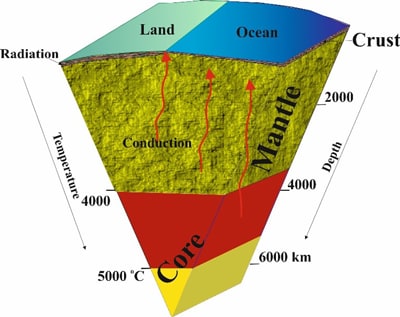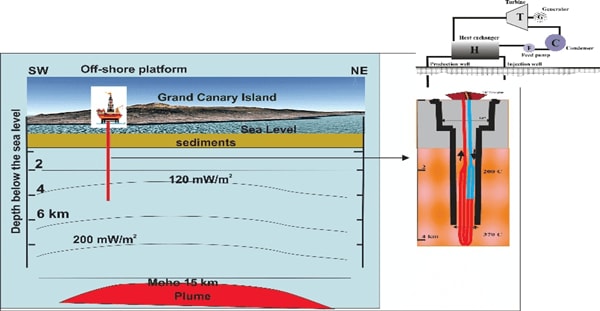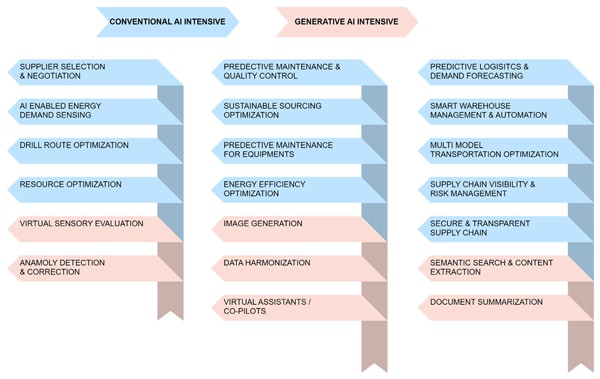Artificial Intelligence
Green Energy: Geothermal Energy with Ai-First Sustainable Development
This whitepaper explores a new method of extraction of heat from granite from any depth using a U-tube design has been proposed here that is designed especially for bore-wells tapping thermal energy from volcanic islands and can be positioned over off-shore platforms augmented by AI and GenAI Vision models.
Insights
- As part of extraction of heat from granite from any depth, the bore-wells used for tapping thermal energy can be empowered by an AI-First approach, augmenting sensors, GenAI and computer vision models (which comprehend complex controls underneath the bore wells).
- This white paper provides reader with information on how Injection pressure, injection fluid temperature, bottom-hole temperature, production well pressure, production fluid temperature, turbine and generator controls, distribution of power are controlled through AI remotely placed controlled system.
Introduction
Population growth, agricultural expansion, the industrial revolution, and urban development have placed significant stress on water resources. The current regional climate conditions are exacerbating this stress on water and the agricultural sector. In the last decade, green water sources have diminished dramatically, posing a threat of food scarcity to countries. This is particularly evident in GCC (Gulf Cooperation Council) and MENA (Middle East and North Africa) countries. Only 11–13% of the total annual precipitation on continents is available as fresh water, and the entire global population utilizes 2% of this precipitation. Of this small fraction, merely 0.77% supports domestic and agricultural sectors. This amount will be insufficient in the next two decades, as the demand for fresh water is projected to exceed 5000 km³/year (5000 x 10¹² L/year), up from the current demand of 4000 km³/year. Consequently, the world is heading towards severe water scarcity.
For a global population of 8 billion, with a daily requirement of 1000 liters per person, the current demand for freshwater amounts to approximately 8 trillion liters per day (2930 cubic kilometers per year). To address this challenge, nations have embraced the concept of virtual water trade, allowing agricultural products to move from one country to another, thereby distributing water resources on a global scale. Countries have recognized that certain practices are unsustainable, a fact that became indisputable during the COVID-19 period. To ensure water and food security, the desalination of seawater is being employed. From virtual water network the world should move towards water independent countries.
The world is adopting desalination to secure water supplies. However, desalination of seawater is an energy-intensive process. Currently, millions of liters of oil are used for desalination. To produce 1 m³ of water, 2 to 7 kWh of electricity is required, which is not a sustainable solution.
Green Energy from Earth
The exploration of geothermal resources requires managing numerous uncertainties, presenting challenges for investment and operational decisions. Data centers and semiconductor plants, with their high energy demands, necessitate a reliable power source. Geothermal energy has the potential to supplant fossil fuels, thereby transforming the global energy landscape into a more sustainable one. To meet the demands of innovation, there is a push to develop AI solutions that optimize geothermal power generation. This includes identifying the most productive underground locations for maximum clean energy output. An energy source that is carbon footprint-free and can rival the efficiency of fossil fuels is the heat from the Earth. Geothermal energy is the sole solution that can provide a sustainable water-food system for the world. This energy is free and accessible from any location on Earth.
By developing AI algorithms/models that interpret surface patterns to predict geothermal potential, and utilizing geological modeling to pinpoint optimal well locations, we can ensure access to the hottest zones and maximize power generation potential. Prediction of values over time (or multi time variant) time series or regression problem.
The goal is to create and deploy the technology and systems needed to simultaneously reduce emissions while meeting the world’s growing energy demands, ensuring progress for people and the planet, on the journey to net zero and beyond.
Figure 2. Energy Beneath our feet

Energy continuously flows from the Earth to the surface via conduction. The heat flux from the Earth creates a temperature gradient of approximately 35°C per kilometer. Moreover, the Earth's crust contains a large amount of radioactive elements that contribute to this heat flux. It is now possible to commercially harness this free energy through a technology known as Enhanced Geothermal Systems (EGS). The magnitude of energy produced by EGS cannot be matched by current renewable sources such as solar and wind.
Technology to tap EGS source.
Enhanced Geothermal Systems (EGS) are a technology used to harness the Earth's internal heat for generating electricity and other direct applications. A borehole is drilled into granite, a common type of rock in the Earth's crust, to depths of 3 to 4 km where temperatures range from 350-400°C. Heat exchanger tubes are then inserted into the borehole to extract the heat using water or liquid carbon dioxide, as illustrated in Figure 3. In the context of climate change and global warming, the strategies adopted to mitigate related disasters have not yielded satisfactory results with commonly adopted renewable energies. These methods have not demonstrated significant advantages or reductions in greenhouse gas emissions. Contrarily, sources like solar PV, wind, and biomass, often touted as green energy solutions, are causing more environmental damage than fossil fuels. These sources ultimately rely on fossil fuels for their development, contradicting the primary objective of reducing GHG emissions and achieving the UN Sustainable Development Goals (SDGs). Approximately 15,000 island nations depend on imported energy, food, and other commodities. These islands possess an immense amount of heat beneath them and represent untapped EGS fields. Harnessing the abundant geothermal energy at no cost and with a zero-carbon footprint could fulfill several SDGs for island nations and the world at large. Figure 3 presents a schematic diagram of a stand-alone offshore platform harnessing supercritical temperatures beneath islands to operate a geothermal power unit that generates electricity. Water or liquid CO2 is circulated through the blue tube, where it is heated, evaporated, and then rises to the surface at a temperature of 200°C. This heated liquid then flows through a heat exchanger containing a low boiling point organic fluid.
Figure 3. Enhanced Geothermal Systems

The fluid evaporates, creating high pressure that drives a turbine connected to a generator, thereby producing electricity. This process operates continuously, 24/7, regardless of external weather conditions. The system boasts an efficiency greater than 90%. It emits no carbon dioxide, and the electricity produced is environmentally friendly. This supercritical Enhanced Geothermal System (EGS) is capable of generating 40 MWe. Multiple platforms can be installed offshore, depending on energy demand.
Utilization
Each megawatt-electric (MWe) produced by this supercritical heat source can supply 7,884 megawatt-hours (MWh), or about 8 million kilowatt-hours (kWh) of electricity. This represents a significant amount of energy. This free energy can be harnessed for electricity generation, desalination to produce fresh water, support for domestic and agricultural sectors, and to produce green hydrogen and ammonia. The list underscores the economic significance of Enhanced Geothermal Systems (EGS) for island nations. Without relying on fossil fuels, these countries can achieve independence in water, food, and energy, and can pursue a growth-oriented, sustainable economy. Hydrogen produced through the electrolysis of water is considered true "Green Hydrogen." Since electrolysis is an energy-intensive process, using fossil fuels for this purpose is not cost-effective. However, with the availability of free energy, island nations have the potential to become global centers to produce green hydrogen. As an added value, this hydrogen can be used to produce green ammonia, paving the way for a global supply chain network for green hydrogen and ammonia.
Industry outlook for Geothermal source
Shifting Focus:
- To build a thermal power plant it takes 3 to 4 years. And the cost of 1 MW thermal power plant varies from Rs. 8.34 Cr to 11 Cr. Add to that the fuel supply cost is dynamic in thermal power plant.
- There are hidden costs for thermal power plants (environmental cleaning and supply of fuels from different regions).
- To construct a nuclear power plant, it takes 7 to 8 years.
- Establishing a geothermal power plant costs the same as thermal power plant.
Tech Adoption: Exponential evolution in data, technology & AI drive value in Geothermal industry.
Rising Tide: GenAI Vision models are very helpful in processing large volume of subsurface data to identify a potential site for drilling. The time taken to process the site selection data, using normal computational devises takes several months. Vision models can cut short this time and prepare the next stage of drilling for resource evaluation. There is a good amount of cost savings in this process.
Quantum Leap:
- ROI = Energy delivered to the society/ Energy required to produce that energy.
- Since the denominator is small (energy is free and investment on energy source is one time and it is not dynamic like other energy sources), the ROI is high. For geothermal power plants it varies from 2 to 6.
- The payback period for geothermal power plant is 5 years while it is 8 years for thermal plants.
- Geothermal power plants lifetime is 40 to 50 years without any break.
Sustainability goals taking huge setback due to global events and energy availability.
Geothermal Business Value Stream and The Role Of AI:
The geothermal fluid flow rate, the temperatures at the injection and production wells, the temperature of the injection fluid, and the quantity of electricity generated (which can be increased or decreased based on demand) are critical parameters. As these units operate independently from remote locations, a regulatory mechanism is necessary for:
- Injection flow rate
- Production flow rate
- Injection fluid temperature
- Production fluid temperature
- Power generation quantity
- Power production regulation based on demand
- Maintenance of offshore rigs and system components
- Desalinated water production
- Green hydrogen and ammonia production
AI can play a major role in the following project execution items:
- Site selection - Geological and geophysical data is collected during this period. Huge subsurface data based on Magneto-telluric, petrophysical, deep resistivity and shallow bore well data are collected.
- The data collected is over hundreds of sq. km. 3D models are created based on the data to construct subsurface geothermal regime and geothermal reservoir configuration.
- During shallow drilling to collect thermal regime of the site, the drilling process is monitored continuously to understand and analyze the subsurface strata, existing dislocations along the trajectory of the drill hole, groundwater table profile through predictive maintenance for equipment’s, computer vision, anomaly detection etc.
- Subsurface heat is transferred to the surface using a continuous flow of water or liquid carbon dioxide. The flow rate should be maintained at 70-80 kg/s to generate 40 MW of electricity. Heat extraction, flow of fluids, monitoring underground reservoir temperature are major system components that needs constant check. This process can be accomplished by AI from a remote center. Electricity generation will be an ongoing process from more than 100 sites across the large region. The power plants are stand-alone units placed at remote sites in island countries.
- To give an example, in a thermal power plant, to get a constant power out-put the following processes should be constantly checked: fuel input, quality of the fuel, temperature generated to boil the water, volume of steam generated, velocity of the steam that is jetting out into the turbine blade, rpm of the turbines, rpm of the generator, electricity out-put, its voltage, amperes etc. being supplied to the power grid. All these processes need to be synchronized. Even a small defect in any process results disruption of the generation of power. AI can pre-empt the fault and caution the operator. These are not new but are currently carried out by normal customized computer panels monitored by humans. AI can do independently and take appropriate decision and correct the faults.
- AI tools here are very helpful in processing large volume of subsurface data to identify a potential site for drilling. The time taken to process the site selection data, using normal computational devises takes several months. AI can cut short this time and prepare the next stage of drilling for resource evaluation. There is a cost savings in this process.
Geotherm AI Use Cases:

Narrow Transformer GenAI model contextualized for the geothermal specific knowledge and domain as opposed to general-purpose LLMs helps our Geothermal use cases. These models must be parameter efficient fine-tuned using custom datasets(Geological and geophysical data) on a relevant open-source pre-trained model fine-tuned for the geo-thermal scope. Narrow transformers offer a powerful and efficient way to leverage GenAI technology within streamlining workflows, monitoring, measuring, improving communication, and boosting crew productivity.
Key Considerations & Limitations:
- Choose an appropriate model based on the task.
- Consider model size, training data, existing community support etc.
- Decide on the fine-tuning approach.
- Gather high-quality, geothermal-specific training data.
- Ensure the data coverage with diverse range to improve model robustness.
- This model can be integrated into existing geo-thermal systems, tools and workflows.
- Model can inherit biases from the data they are trained, careful data selection and monitoring are crucial.
Economics
Given the oil industry's expertise in drilling deep wells and constructing stand-alone platforms, they could be valuable partners in this venture. Thermo-hydro-mechanical models of Enhanced Geothermal Systems (EGS) have shown that the Levelized Cost of Power (LCOP) generated from islands using EGS technology could range from 6 to 7 US cents per kWh, without any hidden costs, unlike power produced from fossil fuels.
Regarding the cost of desalinated water, a consistent supply of freshwater will be available to support domestic and agricultural needs, regardless of weather conditions, liberating the islanders from reliance on food imports. Currently, the cost of freshwater produced via desalination using fossil fuels stands at US$1 per cubic meter. This cost is projected to decrease by more than 50% when utilizing the free energy source provided by EGS.
Blue Economy & Growth Opportunity
Given that energy is free, devoid of hidden costs and environmental concerns, both the energy and IT sectors stand to gain significant financial benefits and opportunities for robust economic growth. Island nations could become centers for energy (green hydrogen), as well as food and water production. An AI First & AI controlled supply chain network could oversee the entire system, leading to uniform sustainable development and a world free from conflicts over water, food, & energy.
Energy transmission and distribution system is not specific to geothermal power plants. T and D is an inherent component/issue to any power plant. What is known as load distribution during peak and non-peak periods. AI can monitor the T and D and take a decision in supplying priorities. For example, if the power demand is low, AI can reduce power production from a power plant.
Decommissioning a geothermal plant arises after 40 to 50 yea or more. For example, the Larderello geothermal power plant is 100 years old and is still generating power to its installed capacity. AI will indicate those power plants that are not effectively & efficiently working, decommissioning of such plants follow the protocol of oil rigs.
Conclusion
We can leverage geothermal energy as an energy source to minimize Water & Food Crisis of planet earth. AI augmentation allows for the monitoring of key metrics, saves time and improves productivity, ensuring balanced power generation by addressing AI use cases such as:
- Comprehensive Monitoring Metric Controls underneath borewells
- Power Generation Command Centers (for each source)
- AI-Powered Remote-Controlled system with real-time support
References
- https://geothermal.org/sites/default/files/2021-01/Geothermal%20Energy%20in%20the%20Era%20of%20AI.pdf
- http://www.geothermal-energy.org/pdf/IGAstandard/WGC/2020/33026.pdf
- https://isp.page/news/ai-driven-geothermal-power-generation-challenges-and-opportunities/
- https://geothermal.org/our-impact/blog/digital-solutions-geothermal-power-increase-operational-productivity-and-longevity
- https://link.springer.com/chapter/10.1007/978-3-031-15044-9_13

Subscribe
To keep yourself updated on the latest technology and industry trends subscribe to the Infosys Knowledge Institute's publications
Count me in!









